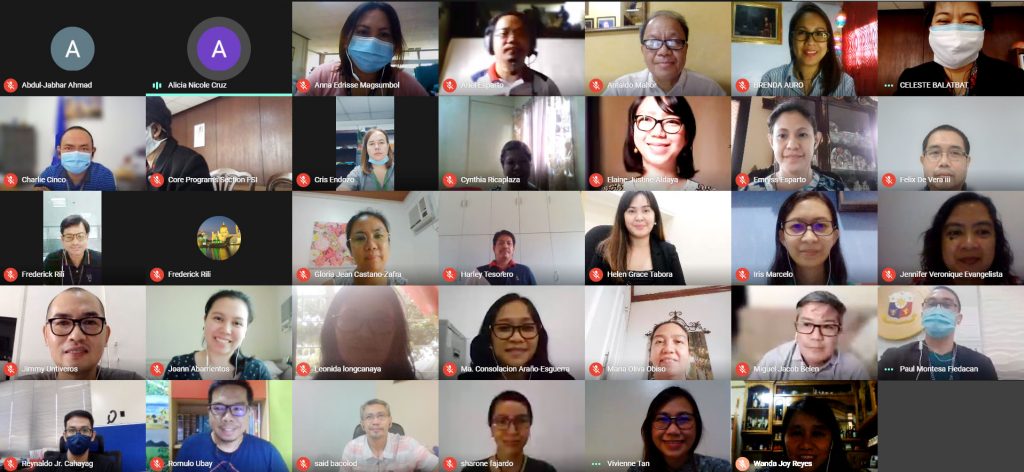Organization
Foreign Service Institute
Best Practice Focus Area/s
Strategy, Operations
Year Implemented
March 2020 – Present
This is a GBPR Entry
Summary
The COVID-19 pandemic propelled massive changes in education and training—moving schools, universities, and institutions towards a shift to online teaching and learning and prompting them to adapt to the “new normal.†To ensure continuity of operations while meticulously observing precautions and safety measures, the Carlos P. Romulo School of Diplomacy (CPRSD) of the Foreign Service Institute (FSI) adopted and transitioned to online learning. However, this paradigm shift revealed several challenges and difficulties, particularly in delivering content and online infrastructure. The shift became smooth and steady with the cumulative effort of FSI’s training specialists and stakeholders.
Background and Problem
FSI-CPRSD’s core function is to provide and capacitate the Foreign Service Corps through its training programs—enhancing and upgrading the competency and skills of its participants to be on par with international standards and keep abreast with the global environment in various fields. The preparation and conduct of CPRSD’s training programs were all implemented via face-to-face instruction. However, in 2020, in response to the rising confirmed cases of the COVID-19 pandemic, the President declared, through Proclamation No. 929, series of 2020, a State of Calamity throughout the Philippines for six (6) months and imposed an Enhanced Community Quarantine (ECQ) throughout Luzon beginning 16 March 2020.
Following this directive, the Department of Foreign Affairs issued Department Circular No. 08-2020 on 18 March 2020, requiring its offices to implement a work-from-home arrangement except for those rendering emergency frontline and other critical services, which shall ensure a skeletal workforce. This prompted the FSI to shift the conduct of training programs from face-to-face to online. The paradigm shift revealed several challenges and difficulties, particularly in delivering content, low technological skills, and online infrastructure.

Solution and Impact
As the Institute embarked on online learning to respond to the pandemic’s challenges, the following were the summarized steps implemented in shifting to online learning:
- A survey determined an initial assessment of the readiness and learning needs of three sets of course participants, resource persons, and training specialists. The data was used for evidence-based decision-making and guided Learning and Development (L&D) action planning. CPRSD was able to identify the level of readiness; plan appropriate learning intervention, and adjust the teaching method, platform, material, and mode based on the data.
- To support the shift to online learning and plan appropriate interventions in the training programs, CPRSD procured Profiles Asia Pacific Inc. as the service provider for the L&D Programs on Online Learning and Consulting Services. Applying relevant and timely knowledge with their enhanced skills in course design and online facilitation, CPRSD was able to convert and redesign its face-to-face training programs into online learning sessions.
- With the FSI’s shift to online learning, CPRSD has utilized Google Workplace and Zoom as the leading platforms. For the delivery of the synchronous sessions, Google Meet (one of the tools of Google Workplace) and Zoom are being used as they both have helpful features and specifications.
- For the asynchronous courses, participants were given a certain duration to access the Learning Management System, finish the modules, and go through the final assessments at their own convenient time. They could also revisit the course’s content and the assessments even after completing the asynchronous online course for review and retention.
- Most of the readings and other instructional materials were digitized using online platforms and uploaded for file sharing and ease of access for the participants. These were sent to the participants before the scheduled sessions, allowing them to prepare for the sessions and do an advanced reading.
- To assist the participants and resource persons/instructors before, during, and after the training programs, CPRSD crafted the FSI Online Training Rules to serve as a guide in making their online learning an easy and successful experience.
- In preparation for implementing the online training programs, briefings and test calls for the participants were scheduled days ahead. The resource persons/instructors may request test calls should they need such for simulation practice. The aim was to help the participants understand the rules and expectations, increase engagement, get familiar with the platform, ready the equipment to be used, and set the mood/atmosphere of the course/training.
- Despite the restrictions to conducting face-to-face training and the challenges of the shift to online learning, CPRSD implemented 60 online synchronous courses, producing 1,178 course completers and 13 online asynchronous courses with 456 completers. These courses were conducted from the second to the fourth quarter of 2020.
Milestones/Next Steps
FSI’s sudden shift to online learning and adaptation to the “new normal†has been unprecedented, like the experience of any other agency or institution. But as the institute’s experience showed, shifting to online learning increased the opportunities for the FSI and its clients. In fact, because of the expansion of access, there was a dramatic increase and growth in the number of participants who could join the synchronous sessions and enroll in the asynchronous courses, surpassing the targets set for 2020. This increased accessibility, through the online modality and the platforms used, attracted interest among the DFA personnel from the Consular Offices and Foreign Service Posts. The online courses saved resources, time, and money—increasing the productivity of the personnel.
